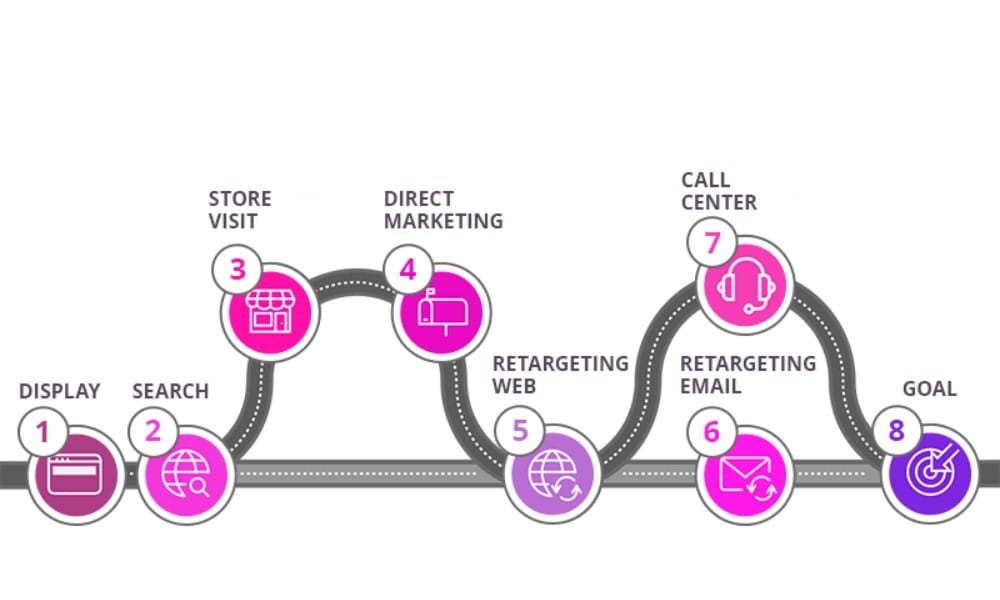Contents
Do you remember the million-dollar Number 55 bet between Will Smith and BD Wong at the Superbowl game in the movie Focus? If you haven’t seen the movie, Will Smith won the bet because he was aware of what we call multi-channel attribution.
Will Smith bet his entire weekend’s earnings that Margot Robbie would be able to guess the number of a player that BD Wong picked at random. However, unknown to BD Wong, he’d been “primed” to choose 55 because it was all around him the whole weekend: in a poster in the elevator, on the hotel doorman’s lapel, the replica jerseys the spectators wore before the game, and even on the placards some demonstrators held up on the road to the stadium.
Multi-channel attribution works the same way. When you share the same idea through different channels, it eventually latches to your audience’s mind. It can be via Google Ads, a blog, a banner ad, email marketing, a YouTube recommendation, and more.
With so many potential traffic sources, you need to know which channels contribute the most towards conversions.
What is Multi-Channel Attribution?
Multi-channel attribution is where you assign value to each channel to see which ones have the most impact on the user journey. You can use multi-channel attribution to track conversions or leads. The underlying goal of multi-channel attribution is to understand which channels your audience uses to engage with your business.
A typical customer journey roadmap will include various marketing channels, for example, display advertising, SEO, social media, and email marketing. You need to be able to track how people engage with you across these various channels. A customer management system can help with that. A business phone system can also help you track customer engagement by phone or video call.

Having so many channels available is great for a business. However, it’s also a problem.
You need to understand the value of each channel to allocate your resources effectively. For example, if you know that paid ads are generating most of your leads, it might make sense to increase your ad spend.
Multi-channel attribution helps you identify the most effective channels. It also helps you understand which channels people engage with across the customer journey.
Why is Multi-Channel Attribution Important?
When you spend your hard-earned money on marketing, you would want to know which channels drive your business growth. The graph below reveals some of the reasons why marketers think multi-channel attribution is so important:

Multi-channel attribution gives your business a better understanding of the dynamics between different channels. You also gain insights into audience behavior, enabling you to make more informed decisions for budget allocation and campaign planning.
Types of Multi-Channel Attribution Models
Ask 10 different marketers what they mean by “multi-channel attribution,” and you’re likely to get 10 different answers. When it comes to calculating return on investment (ROI) and justifying marketing expenditure and initiatives, marketers may pick the model that makes their team look best.
The multi-channel attribution models we’ll discuss in this section are among the most popular among marketing analysts. There’s no single definitive method of doing multi-channel attribution – the most effective one will be what works for your business.
Last Adwords Click
Last Adwords Click gives 100% credit to the last Google Ads marketing advertisement, right before the visitor or lead converts or buys a product. Let’s go over an example of how this can work.
You’re running a Google ad for the client’s weight loss product webinar. When a site visitor clicks on the ad and shares their information to register for the webinar, you can award full credit to the ad for generating the conversion.
This attribution model is useful when looking for the single channel that resulted in the user taking the desired action. As far as data goes, this approach is one of the most accurate, as it gives you a direct one-to-one correlation between triggers and actions.
Because this approach yields accurate data, you can convert that data into actionable insights and use your findings to design multichannel campaigns with more precision and accuracy. However, the approach will give greater value to paid advertising.
As a result, you’re more likely to see paid ads playing an important role in the conversion, even if the person first encountered your company through the blog.
Last Non-Direct Click
Last Non-Direct Click can be a bit confusing, so let’s start by breaking it down into bite-sized chunks.
First, “non-direct” means any marketing channel other than the one that led directly to the desired action. Second, “last” refers to the last non-direct channel that the user encountered before acting.
The attribution model provides 100% credit to the second-to-last channel that the user encountered before tracking the action. For instance, if the user saw a blog post about the product before coming across an ad that led directly to your product page, the blog post will get 100% credit.
You might be wondering why you’d track the second-to-last touchpoint. Google Analytics uses this model for non-multi-channel reports by default. It can also help you filter out traffic from customers who have already converted through a different channel. That lets you focus on the last marketing activity they encountered before conversion.
First interaction
First Interaction attribution gives credit to the first component in the multi-channel marketing cohort. For example, if a person found your company through the blog, your search engine optimization (SEO) would get the attribution.
This analysis model is helpful when you run campaigns to create initial awareness about the brand or product. The limitation is that you don’t track the subsequent interactions.
Linear Attribution
The linear attribution model gives an equal share to every marketing channel over the customer journey. The model allocates each channel an equal value.
For instance, if a customer clicks on a Google Ad, registers for your brand’s mailing list, searches for your products on Google, and purchases through Facebook Marketplace, the model will give 25% credit to each channel.
Time decay
The time decay model works similarly to linear attribution. However, it rewards the most recent touchpoints with a larger share of the credit. Most time decay models have very short lifespans.
If a customer encountered a touchpoint one day before the conversion, that channel would get 50% credit. If the same customer encountered a different touchpoint seven days before converting, that channel would receive 25% of the credit, and so on.
Time decay models are most useful for measuring the effectiveness of things like short-term discount campaigns. If your ecommerce site runs a one-day sale, you’re more likely to generate leads on the day itself than through sale teasers you run the week before the sale.
Time decay models can give you a nice sense of the customer journey. It provides more balanced insights than last-touch attribution.
Position-Based
The position-based multi-channel attribution model is a hybrid of the last interaction and first interaction models. It gives the first touchpoint and the last channel 40% of the credit while awarding 20% to touchpoints in the middle of the customer life cycle.
This approach is most useful when you want to recognize the channel that made the customer aware of your brand and directly led to the conversion.
There’s also a mixed approach to the marketing channels. The hybrid position model includes the first and last interaction touchpoints, giving them an equal share of 40%.
The remaining 20% credit goes to all the other channels used between the first and last interaction. This model is proper when you give equal credit to the touchpoints that introduced the customer to the brand and led to conversion.
In Conclusion
As marketers, we’re utilizing an increasing number of channels to engage with our audience and ultimately fill the sales pipeline. Multi-channel attribution helps marketing teams understand which channels they’re using to help develop a lead from prospect to customer.
Using these multi-channel attribution models, you can learn more about the channels that perform and those that don’t. You can also discover the triggers and factors that generate conversions.
When you perform multi-channel attribution, you can improve your marketing campaigns and understand your customers better, leading to better ROI and higher customer satisfaction.
If you liked this article, be sure to follow us on Facebook, Twitter, and LinkedIn! And don’t forget to subscribe to our newsletter.









Leave a Reply